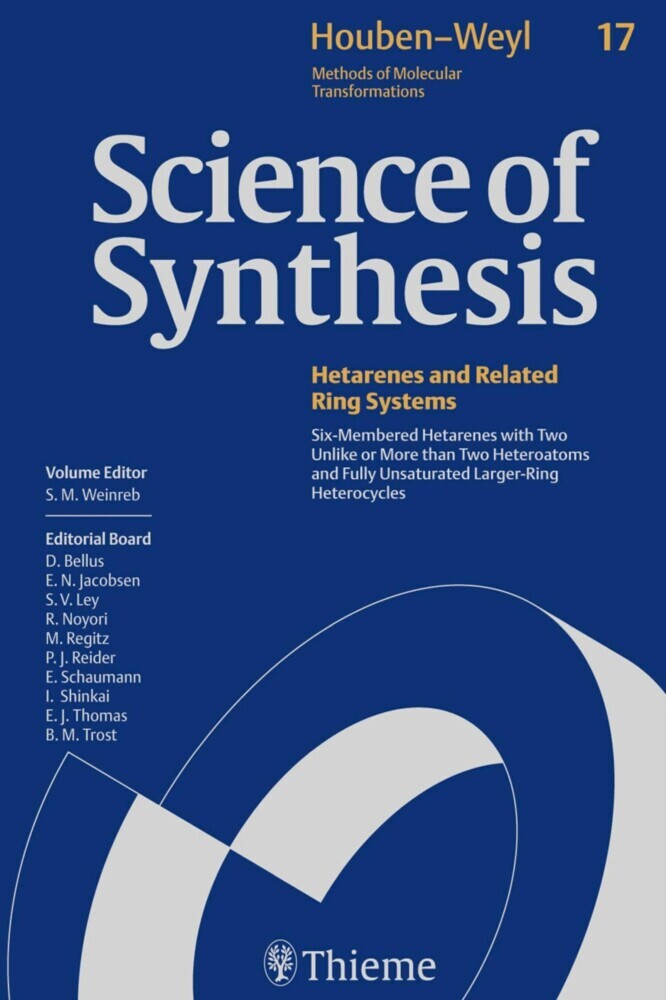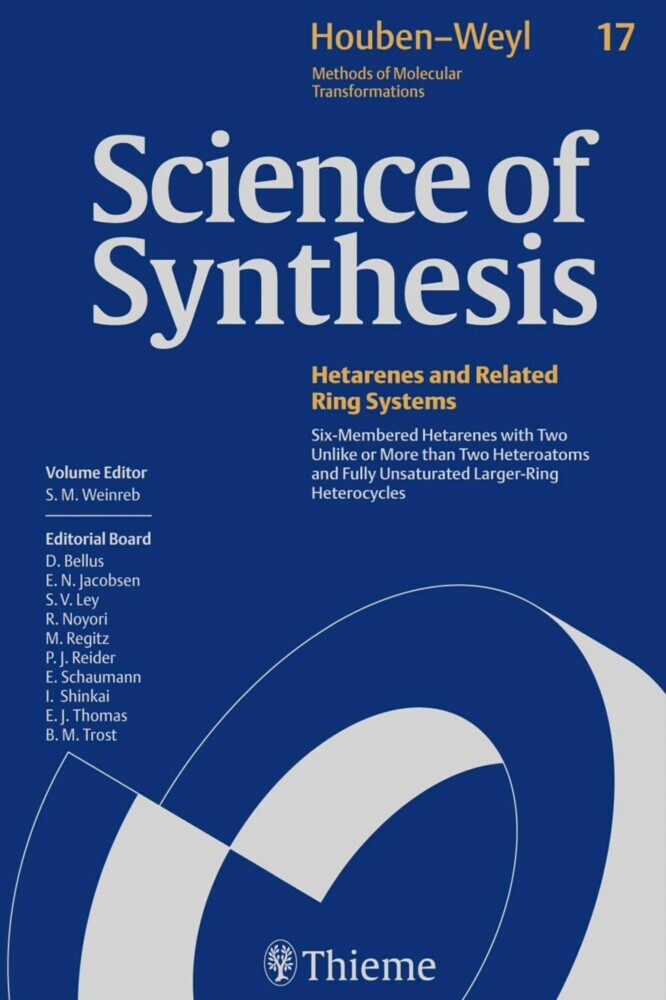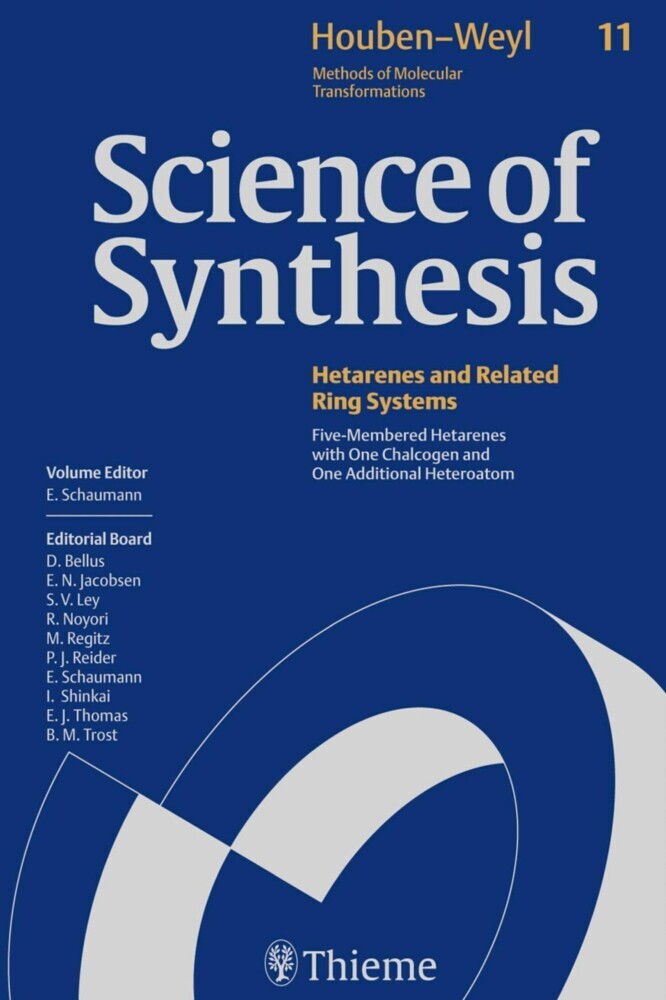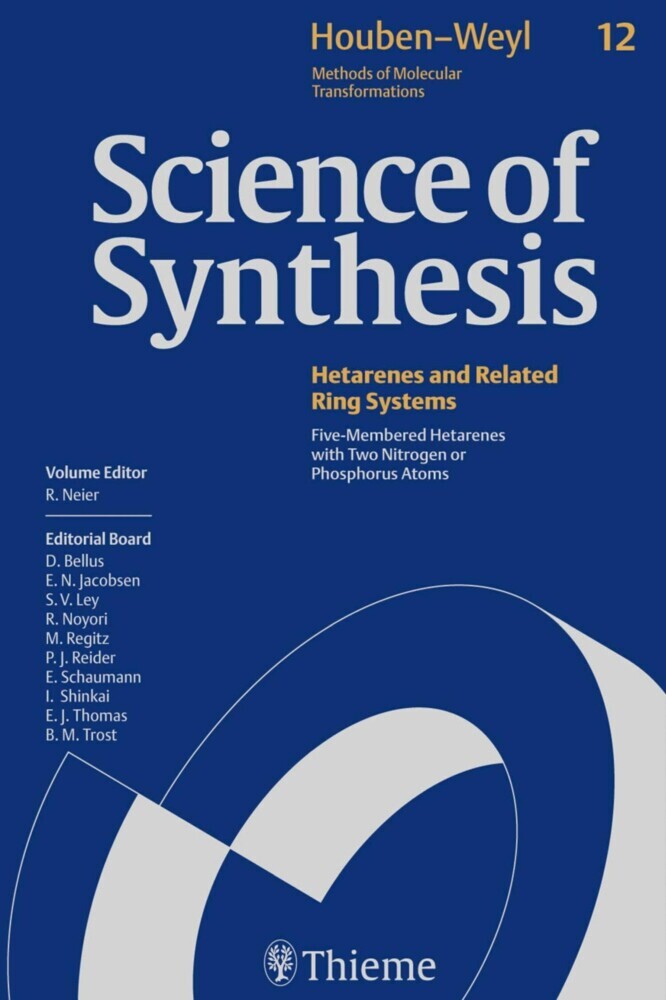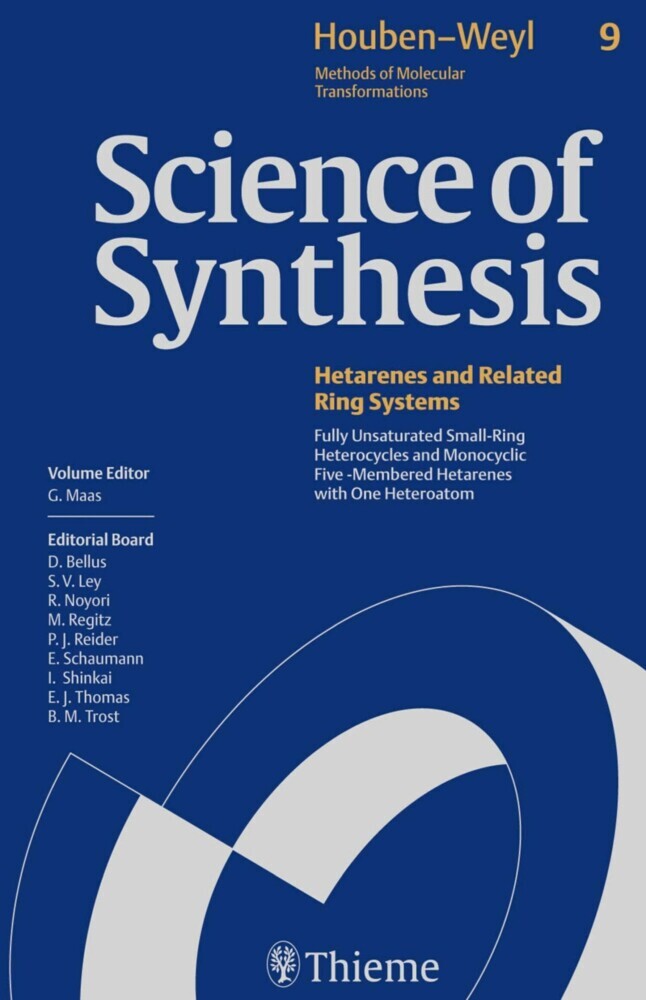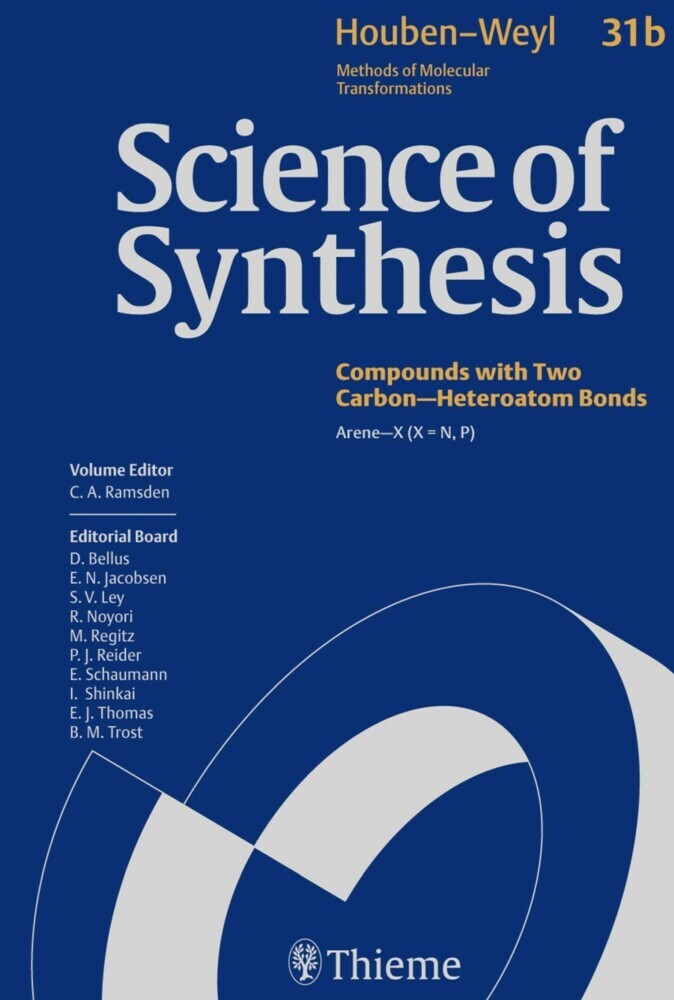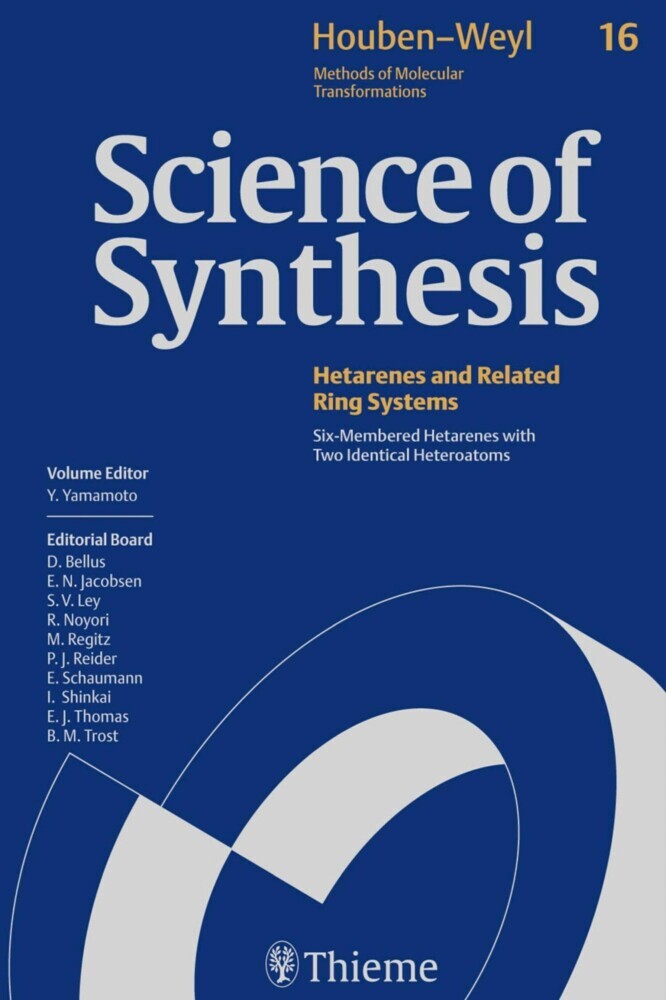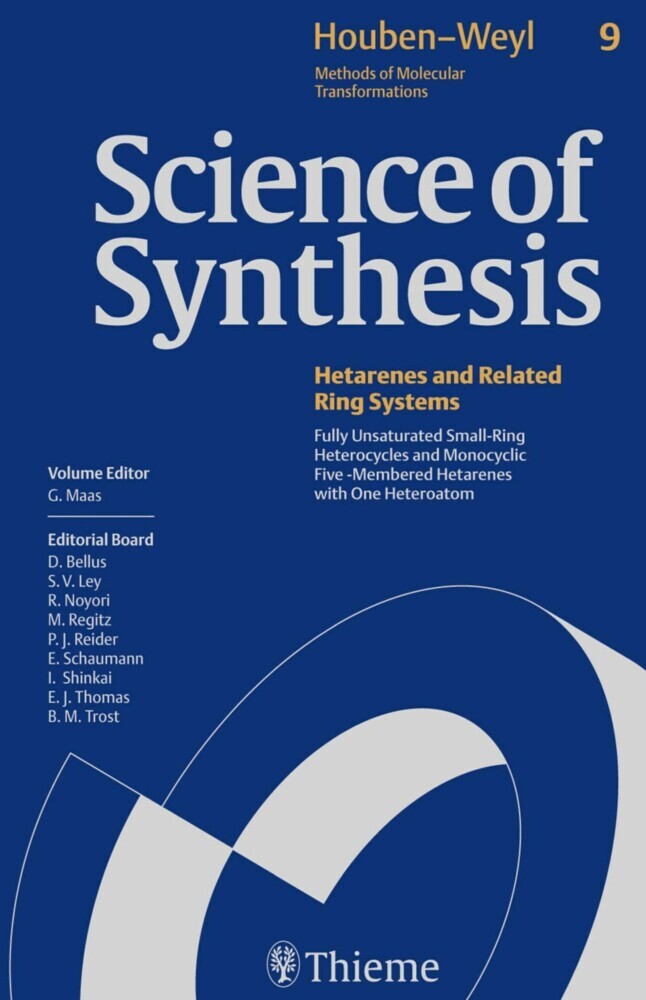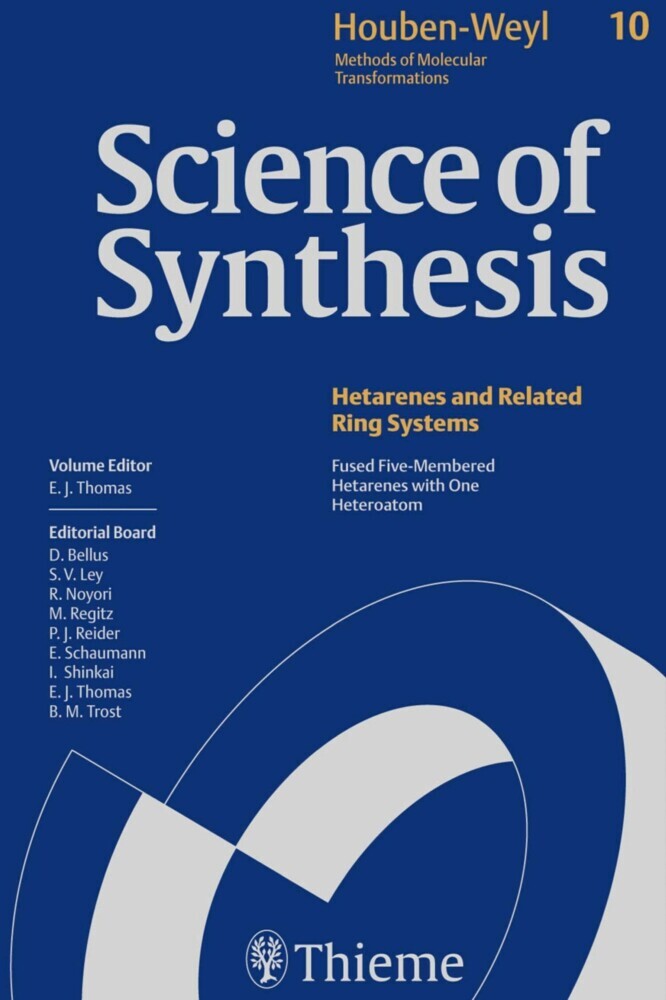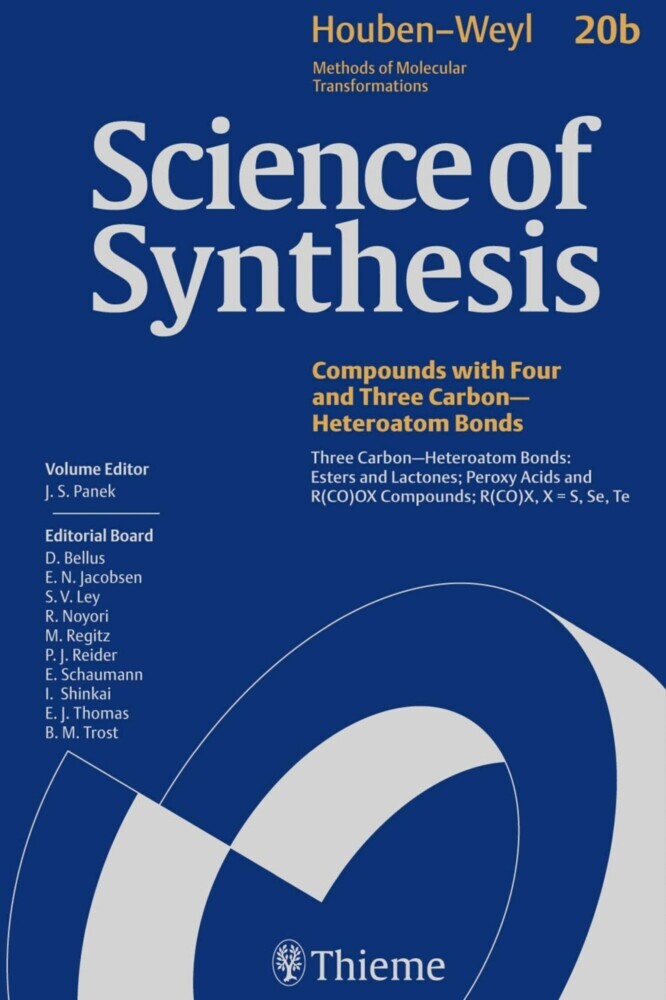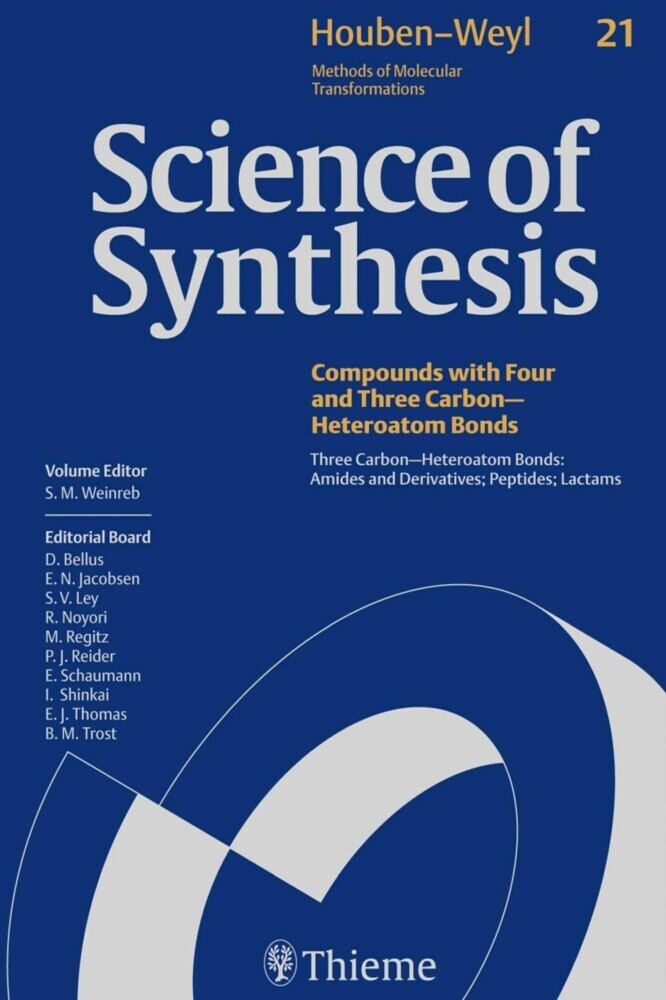Science of Synthesis: Houben-Weyl Methods of Molecular Transformations Vol. 17
Six-Membered Hetarenes with Two Unlike or More than Two Heteroatoms and Fully Unsaturated Larger-Ring Heterocycles
Science of Synthesis: Houben-Weyl Methods of Molecular Transformations Vol. 17
Six-Membered Hetarenes with Two Unlike or More than Two Heteroatoms and Fully Unsaturated Larger-Ring Heterocycles
Science of Synthesis: Houben-Weyl Methods of Molecular Transformations is the entirely new edition of the acclaimed reference series Houben-Weyl, the standard synthetic chemistry resource since 1909. This new edition is published in English and will comprise 48 volumes published between the years 2000 and 2008.
Science of Synthesis is a quality reference work developed by a highly esteemed editorial board to provide a comprehensive and critical selection of reliable organic and organometallic synthetic methods. This unique resource is designed to be the first point of reference when searching for a synthesis strategy.
- Contains the expertise of presently 400 leading chemists worldwide
- Critically evaluates the preparative applicability and significance of the synthetic methods
- Discusses relevant background information and provides detailed experimental procedures
For full information on the Science of Synthesis series, visit the Science of Synthesis Homepage
1;Science of Synthesis - Volume 17: Six-Membered Hetarenes with Two Unlike or More than Two Heteroatoms and Fully Unsaturated Larger-Ring Heterocycles;1 1.1;Title page;3 1.2;Imprint;5 1.3;Preface;6 1.4;Volume Editor's Preface;8 1.5;Overview;10 1.6;Table of Contents;12 1.7;Introduction;72 1.8;17.1 Product Class 1: Six-Membered Hetarenes with Two Unlike Heteroatoms;90 1.8.1;17.1.1 Product Subclass 1: Two Unlike Oxygen, Sulfur, Selenium, or Tellurium Atoms;90 1.8.1.1;17.1.1.1 1,4-Oxathiins;92 1.8.1.1.1;17.1.1.1.1 Synthesis by Ring-Closure Reactions;92 1.8.1.1.1.1;17.1.1.1.1.1 Method 1: Reaction of Sulfur Dichloride with Divinyl Ether;92 1.8.1.1.2;17.1.1.1.2 Synthesis by Ring Transformation;93 1.8.1.1.2.1;17.1.1.1.2.1 Method 1: Rearrangement of 1,3-Oxathiolanes;93 1.8.1.1.3;17.1.1.1.3 Aromatization;93 1.8.1.1.3.1;17.1.1.1.3.1 Method 1: Dehydrochlorination;93 1.8.1.1.3.2;17.1.1.1.3.2 Method 2: Pummerer Reaction;93 1.8.1.1.4;17.1.1.1.4 Synthesis by Substituent Modification;94 1.8.1.1.4.1;17.1.1.1.4.1 Addition of Heteroatoms;94 1.8.1.1.4.1.1;17.1.1.1.4.1.1 Method 1: Oxidation of a Ring Sulfur;94 1.8.1.1.4.2;17.1.1.1.4.2 Modification of Substituents;95 1.8.1.1.4.2.1;17.1.1.1.4.2.1 Method 1: Condensation Reaction of the Carboxy Group with Aniline Derivatives;95 1.8.1.2;17.1.1.2 Annulated 1,4-Oxathiins;95 1.8.1.2.1;17.1.1.2.1 Synthesis by Ring-Closure Reactions;95 1.8.1.2.1.1;17.1.1.2.1.1 By Annulation to an Arene;95 1.8.1.2.1.1.1;17.1.1.2.1.1.1 By Formation of Three Heteroatom--Carbon Bonds;95 1.8.1.2.1.1.1.1;17.1.1.2.1.1.1.1 Fragments O--C--C, C--C, and S;95 1.8.1.2.1.1.1.1.1;17.1.1.2.1.1.1.1.1 Method 1: Reaction of Monoimines with Phosphorus Pentasulfide;95 1.8.1.2.1.1.2;17.1.1.2.1.1.2 By Formation of Two Heteroatom--Carbon Bonds;96 1.8.1.2.1.1.2.1;17.1.1.2.1.1.2.1 Fragments S--C--C--O and C--C;96 1.8.1.2.1.1.2.1.1;17.1.1.2.1.1.2.1.1 Method 1: Reactions Involving Nucleophilic Sulfur and Oxygen;96 1.8.1.2.1.1.2.1.2;17.1.1.2.1.1.2.1.2 Method 2: Cycloaddition Reactions;98 1.8.1.2.1.1.2.2;17.1.1.2.1.1.2.2 Fragments S--C--C and O--C--C;99 1.8.1.2.1.1.2.2.1;17.1.1.2.1.1.2.2.1 Method 1: Reaction of Spiroepoxyhexadienones with Pentahalobenzenethiols;99 1.8.1.2.1.1.2.2.2;17.1.1.2.1.1.2.2.2 Method 2: Autocondensation Reaction of a Sulfonated a-Tetralone Derivative ;100 1.8.1.2.1.1.2.3;17.1.1.2.1.1.2.3 Fragments C--C--O--C--C and S;101 1.8.1.2.1.1.2.3.1;17.1.1.2.1.1.2.3.1 Method 1: Reaction of Diaryl Ether with Sulfur (The Ferrario Reaction);101 1.8.1.2.1.1.2.3.1.1;17.1.1.2.1.1.2.3.1.1 Variation 1: Reaction of Diaryl Ether with Sulfur Dichloride;102 1.8.1.2.1.1.2.3.1.2;17.1.1.2.1.1.2.3.1.2 Variation 2: Reaction of Diaryl Ether with Sulfur Dication;102 1.8.1.2.1.1.2.4;17.1.1.2.1.1.2.4 Fragments C--C--S--C--C and O;102 1.8.1.2.1.1.2.4.1;17.1.1.2.1.1.2.4.1 Method 1: Reaction of Bis(chloroaryl) Sulfide with Oxygen Divalent Nucleophiles;102 1.8.1.2.1.1.2.4.2;17.1.1.2.1.1.2.4.2 Method 2: Reaction of Bis(dihydroxyphenyl) Sulfone with Oxidant;103 1.8.1.2.1.1.3;17.1.1.2.1.1.3 By Formation of One Heteroatom--Carbon Bond;103 1.8.1.2.1.1.3.1;17.1.1.2.1.1.3.1 Fragment S--C--C--O--C--C;103 1.8.1.2.1.1.3.1.1;17.1.1.2.1.1.3.1.1 Method 1: Cyclization of a 1,2-S,O-Substituted Diaryl Ether;103 1.8.1.2.1.1.3.2;17.1.1.2.1.1.3.2 Fragment O--C--C--S--C--C;104 1.8.1.2.1.1.3.2.1;17.1.1.2.1.1.3.2.1 Method 1: Alkylative Cyclization of 2-(Arylsulfonyl)ethanone;104 1.8.1.2.1.1.3.2.2;17.1.1.2.1.1.3.2.2 Method 2: Cyclization of Diaryl Sulfides and Sulfoxides;105 1.8.1.2.1.2;17.1.1.2.1.2 By Annulation to the Heterocyclic Ring;106 1.8.1.2.1.2.1;17.1.1.2.1.2.1 Method 1: Annulation of Heterocycles;106 1.8.1.2.1.2.2;17.1.1.2.1.2.2 Method 2: Annulation of Carbocycles;107 1.8.1.2.2;17.1.1.2.2 Synthesis by Ring Transformation;107 1.8.1.2.2.1;17.1.1.2.2.1 Method 1: Ring Enlargement;107 1.8.1.2.2.2;17.1.1.2.2.2 Method 2: Formal Exchange of Ring Members with Retention of the Ring Size;109 1.8.1.2.3;17.1.1.2.3 Aromatization;109 1.8.1.2.3.1
Bellus, Daniel
Weinreb, Steven M.
| ISBN | 9783131718914 |
|---|---|
| Artikelnummer | 9783131718914 |
| Medientyp | E-Book - PDF |
| Copyrightjahr | 2014 |
| Verlag | Georg Thieme Verlag KG |
| Umfang | 1500 Seiten |
| Sprache | Englisch |
| Kopierschutz | Digitales Wasserzeichen |

